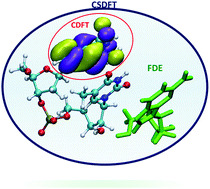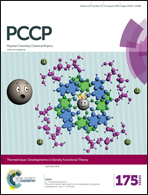Constrained subsystem density functional theory†
Abstract
Constrained Subsystem Density Functional Theory (CSDFT) allows to compute diabatic states for charge transfer reactions using the machinery of the constrained DFT method, and at the same time is able to embed such diabatic states in a molecular environment via a subsystem DFT scheme. The CSDFT acronym is chosen to reflect the fact that on top of the subsystem DFT approach, a constraining potential is applied to each subsystem. We show that CSDFT can successfully tackle systems as complex as single stranded DNA complete of its backbone, and generate diabatic states as exotic as a hole localized on a phosphate group as well as on the nucleobases. CSDFT will be useful to investigators needing to evaluate the environmental effect on charge transfer couplings for systems in condensed phase environments.

- This article is part of the themed collection: Developments in Density Functional Theory

 Please wait while we load your content...
Please wait while we load your content...